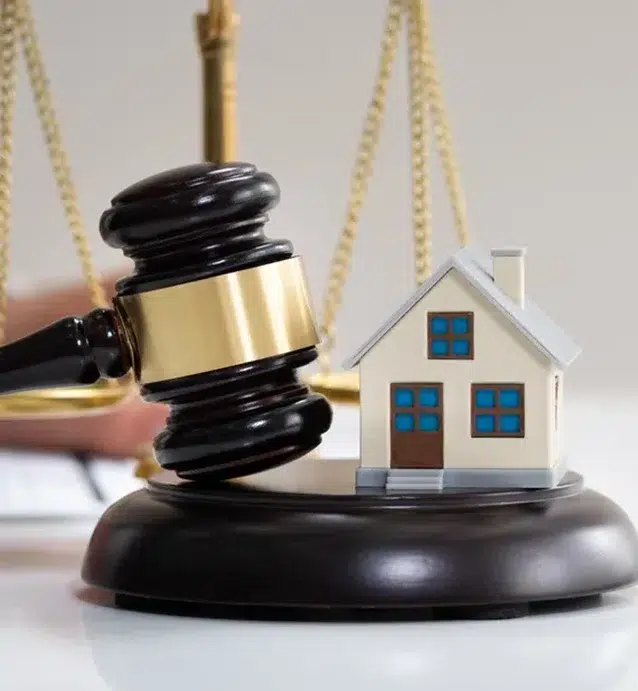As leading real estate attorneys in San Francisco, we’ve helped countless clients safeguard their property investments and resolve complex real estate issues like encroachment. Need top-tier legal advice? Contact us online to schedule a free consultation today.
As a property owner in California, you understand that real estate is a valuable asset. To make the most out of your investment—whether it’s land, commercial real estate or residential property—you need to know exactly where your property begins and ends.
Having a clear understanding of property lines and land boundaries not only provides you with parameters for future expansions but also helps you avoid costly, time-consuming issues like encroachment. In the absence of an obvious solution, these types of real estate issues can escalate quickly, draining your resources along the way.
Luckily, property owners don’t have to navigate encroachment conflicts alone. A talented property and neighbor disputes lawyer with experience in resolving boundary disputes can help ensure this legal issue is handled in the most efficient, advantageous way possible.
This article will explain everything you need to know about encroachment in California, including the difference between encroachment and easement, how to verify an encroachment exists and the best strategies for protecting your property rights.
Need help resolving a land dispute? Don’t wait for the situation to escalate before you ask for help. Call our law firm at 888-982-0599 to schedule an initial consultation today.
Understanding Encroachment in California
In the world of real estate, an encroachment occurs when a property owner puts up a structure that intrudes on (or over) someone else’s property. For example, if a landowner built a barn that went partially over their neighbor’s property line, that would constitute structural encroachment—even if the vast majority of the barn was on the landowner’s property.
Not all encroachments involve structures. Minor encroachments may involve tree branches, large plants growing from one property to the next and even poorly executed landscaping. Although these examples are less likely to result in legal action than structural encroachments, they can still cause a huge headache for everyone involved.
Essentially, encroachment is an invasion of space that can be remedied by civil means. Although some encroachments can be navigated without legal assistance, it’s typically in the best interest of everyone involved to work with a property law expert when deciding how to move forward
Remedying Encroachments
Although boundary issues can be stressful, it’s important to remember that there are several effective strategies for remedying encroachment conflicts. Regardless of which approach you take, you’ll want to start with researching your exact property lines.
Verifying That an Encroachment Exists
Before pursuing a remedy for a suspected encroachment, it’s important to make sure you have a clear understanding of your property boundaries. Without this, it’s impossible to verify whether or not an encroachment is actually taking place. The best way to confirm your boundary line is to get an official land survey; with that information in hand, you and your neighbors can avoid unnecessary conflict over mistaken boundaries.
Communicating with Your Neighbors
The easiest way to clear up encroachment issues is by discussing the issue with your neighbors. If you’re on good terms with them, you may be able to convince them to remove the property or to come to an alternate arrangement. Resolving an encroachment outside of court can save both parties time and money.
If you and your neighbor decide to let the encroachment remain in place, you may want to draft a written agreement or revocable license. Having documentation in place can help prevent a later claim of adverse possession. Another possible resolution is selling them the land on which the encroachment exists.
Filing a Quiet Title Action
If you and your neighbor are unable to resolve the issue, you may want to take legal action. One option is to file a quiet title action, which asks the court to determine if you have “title” to the property affected by the encroachment. If the court determines that you do, it may order the other party to relinquish possession of the portion of the property.
However, quiet title actions aren’t without risk. Depending on the nature of the encroachment and how long it’s been in place, the court may decide that your neighbor has established adverse possession of the encroached upon property. If that happens, the court may award your neighbor title to a portion of the disputed property.

Encroachment vs. Easement
It’s not uncommon for parties who are involved in a boundary dispute to be unclear about the differences between encroachment and easement. Although both involve a property owner making extensions over their neighbor’s property, they are distinctly different.
Encroachments, by definition, are unauthorized extensions made by one property owner onto or over their neighbor’s property. In contrast, a property easement is an agreement made between two property owners to allow the extension, and as such, can be a possible solution to an encroachment issue. It’s important to note that in many cases, the party seeking the easement compensates the other owner for agreeing to it.
Encroachment Attorney Frequently Asked Questions
Real estate law can be surprisingly complex. If you have questions about a boundary issue or possible encroachment, the best way to get clarity is by speaking with a trusted encroachment attorney. In the meantime, read through the answers to some of our most frequently asked questions.
• What if your property is encroaching on someone else’s property?
If you discover that your property is encroaching on someone else’s property, it’s important to get ahead of the situation. There’s a good chance that your neighbor will eventually make the same discovery, and they may be less amenable to a favorable resolution if they feel blindsided. An easement attorney in San Francisco can help you strategize the best course of action.
• Can you sell a house with encroaching land?
Although you can sell a property with an encroachment issue, you may not be able to do so without taking a loss. As a seller, you’re required to disclose encroachment issues to prospective buyers so that they can make an informed purchase decision, and few buyers want to invest in a property with boundary issues.
• Why is it important to address encroachments?
Some minor encroachments can be addressed easily and without legal action. However, you should always—at the very least—address the issue. Letting it slide under the radar without discussing it with an encroaching neighbor can set a precedent of mistaken boundaries, result in expensive legal actions and even leave you vulnerable to adverse possession.

Estavillo Law Group: Trusted Encroachment Attorneys in San Francisco
Property is no small investment, especially in the Bay Area. When your property is being invaded or expanded upon without your knowledge or consent, it’s important to act swiftly. The knowledgeable real estate attorneys at Estavillo Law Group can help you investigate a potential boundary dispute, verify an encroachment and navigate your legal options.

